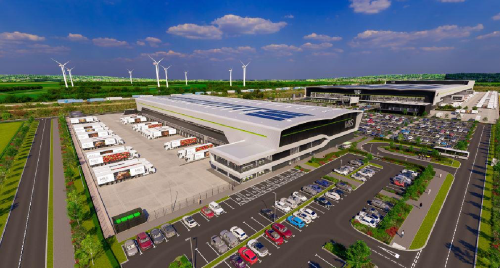London, 21 August 2025 – Marks & Spencer (M&S) has unveiled a landmark £340 million investment in a new 1.3 million sq ft automated National Distribution Centre (NDC) in Northamptonshire, representing the largest single outlay in its supply chain history. The move underlines the retailer’s ambition to double the size of its Food business while reshaping for long-term growth.
The facility, scheduled to open in 2029, will be located at the Daventry International Rail Freight Terminal (DIRFT) – one of the UK’s most strategically important logistics hubs with direct rail and motorway connections.
A Supply Chain Built for Growth
Alex Freudmann, Managing Director of M&S Food, said the investment will deliver the next phase of the retailer’s transformation:
“We’re transforming M&S into a destination for the weekly shop and modernising our supply chain is central to that ambition. This investment will boost capacity for future growth, lower our cost to serve, and improve product availability – ensuring customers find the right products in the right place at the right time.”
Freudmann confirmed that 2,000 jobs will be created during construction, with 1,000 permanent roles to follow, covering logistics, driving, management and technical automation posts.
Automation will play a central role, including:
- Automated pallet cranes for ambient products
- High-speed shuttle systems for sorting and storage
- Hands-free picking solutions that load directly onto store-ready cages
These technologies are expected to reduce replenishment times in-store, boost availability at peak trading moments, and help M&S adapt to volume surges, particularly in the festive quarter when distribution demand triples.
Sustainability as a Core Benchmark
The depot has been designed to achieve a BREEAM Outstanding rating, placing it among the top 1% of sustainable buildings worldwide. Sustainability measures include:
- Rooftop solar arrays and rainwater harvesting systems
- EPC A+ energy efficiency rating
- EV fleet charging facilities and energy-saving technologies
- Responsibly sourced and recycled building materials
The project partners are Prologis (development) and TGW Logistics (automation). Paul Weston, Regional Head at Prologis UK, called the facility “a long-term infrastructure platform tailored to M&S’ future supply chain,” while TGW’s Craig Mitchell described it as “a benchmark for UK grocery logistics.”
Context: Why M&S Needs Scale
The new NDC follows M&S’s £40m investment earlier this year in a 390,000 sq ft distribution hub at Avonmouth, supporting stores across South-West England and South Wales. Together, these projects form part of M&S’s three capital priorities:
- Supply chain capacity
- Store rotation and renewal
- Digital and technology upgrades

image courtesy by mark spencer
M&S has accelerated its store renewal programme, with 12 new food stores on ex-Homebase sites and plans to reshape its 600-store estate into 420 larger Foodhalls and 180 more efficient full-line stores by 2027/28. Food sales, which rose c.20% above target in FY24/25, remain the company’s strongest growth engine, buoyed by shoppers increasingly treating M&S as a full-basket grocery option rather than an occasional treat.
Competitive Landscape
The investment underscores the race among UK grocers to future-proof logistics. Tesco’s distribution modernisation, Sainsbury’s multi-year automation rollouts, and Aldi’s investment in regional DCs have each reshaped capacity to cope with shifting shopper behaviour and e-commerce growth. For M&S, the prize is the ability to scale fresh and ambient grocery while keeping service levels consistent with its premium positioning.
As highlighted in recent GSN coverage of UK grocery automation and Christmas supply chain resilience, efficient logistics networks are now a defining competitive edge, particularly in periods of inflationary cost pressure and rising labour shortages.
GSN Analysis
- Strategic Timing: By announcing a 2029 opening, M&S is signalling confidence in its five-year growth plan while insulating against future capacity bottlenecks.
- Sustainability as Differentiator: The BREEAM Outstanding benchmark is not only a green commitment but a reputational lever in attracting ESG-conscious investors.
- Labour Dynamics: While automation will reduce manual strain, the promise of 1,000 permanent jobs shows M&S balancing technological efficiency with community employment.
Looking Ahead
With Christmas volumes already testing existing depots, M&S’s interim focus will be on Avonmouth and optimising its Bradford NDC. The Northamptonshire hub, once operational, is expected to transform the efficiency curve of M&S Food just as it targets scale against its largest competitors. The challenge will be execution: keeping automation projects on time and within budget while delivering a network agile enough for both festive peaks and weekly shops.




